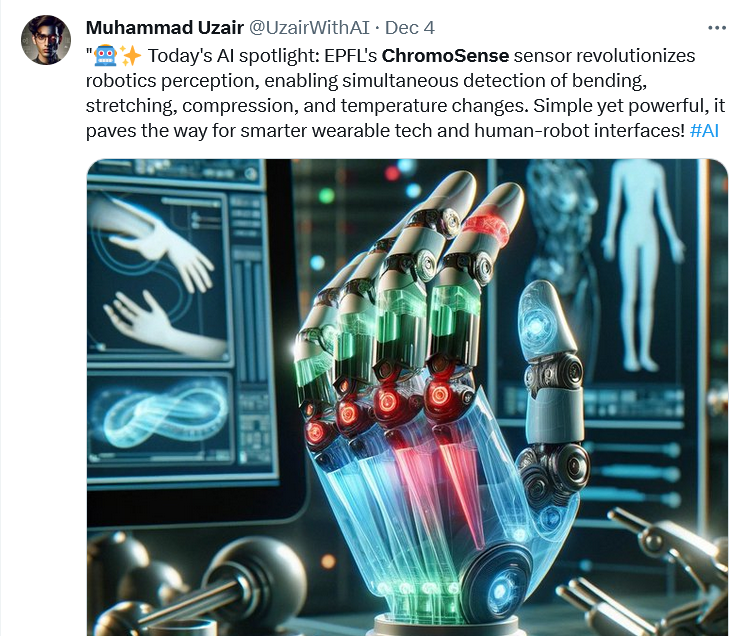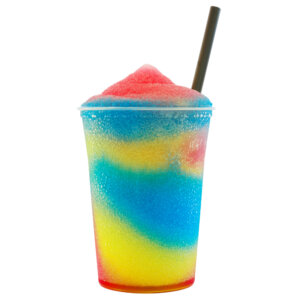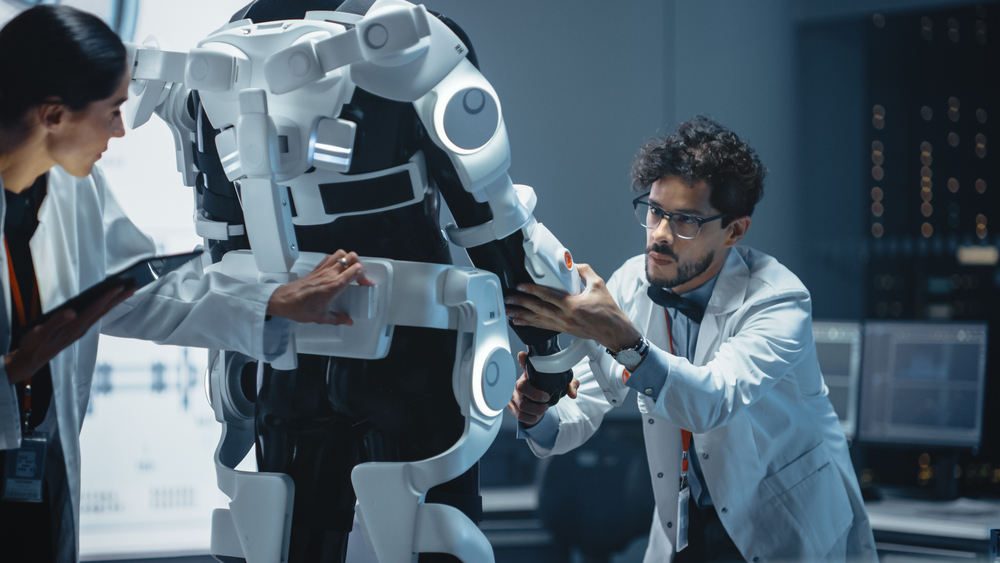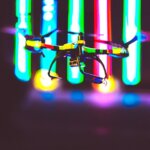Color-based robotic sensing for wearables and soft robotics

• Robot sensing has had significant recent developments, including ChromoSense.
• The technology is sensor-light, helping with the heaviness of traditional robot sensing systems.
• There are hopes that it can be developed so that “anything” can be a robotic sensor.
Researchers at EPFL (École Polytechnique Fédérale de Lausanne), a public research university in Lausanne, Switzerland, have taken further strides in the world of autonomous robot sensing and soft robotics with the development of a new device; one that employs color to detect and respond to various temperature and mechanical stimuli simultaneously.

Chromosense robot sensing – sensing, but pretty!
This new robotic sensor, called ChromoSense, signifies further exciting advancements in wearable technologies and soft robotics.
These latest innovations follow recent significant sensor developments. Robotics researchers have created sensors that are capable of detecting shifts of pressure and position, as well as temperature fluctuations. One area that robotics has continuously failed in is having the ability to sense several stimuli simultaneously. But these latest breakthroughs are revolutionary, especially for wearable devices and human-robotic interfaces, and indicate a significant leap in soft robotics.
ChromoSense – Human-like sensor
ChromoSense is a truly unique sensor with groundbreaking technology. It utilizes color to detect various stimuli, such as stretching, compression, bending, and temperature changes, similarly to how human skin works.
Although an innovative device, ChromoSense is quite simple. It’s comprised of a compact, translucent rubber cylinder with three sections. These sections are dyed separate colors – red, green, and blue. At the top of the device is an LED which beams a light through the cylinder.
When the sensor stretches or bends, the path of this LED light changes as it travels through the three colored sections. At the base of the cylinder, a small spectral meter detects the changes.
Researcher Jamie Paik analogized ChromoSense like this: “Imagine you are drinking three different flavors of slushie through three different straws at once: the proportion of each flavor you get changes if you bend or twist the straws. This is the same principle that ChromoSense uses: it perceives changes in light traveling through the colored sections as the geometry of those sections deforms.”
As flavors change when a straw is twisted or bent, so ChromoSense detects alterations in light as the shape of the sensor changes.

Robot sensing – like a three-color slushy. No, really.
Jamie and her team at Reconfigurable Robotics Lab (RRL) in EPFL’s School of Engineering have also developed a thermosensitive feature, allowing ChromoSense to sense temperature fluctuations. This works via a specialized dye, similar to those found in mood rings, which changes color as temperatures increase.
The future of ChromoSense is bright, but not certain
Robots have traditionally relied on vision-based robot sensing systems to capture different activities and extract necessary data. Nevertheless, these systems, however effective they may be, can make wearable devices quite heavy and uncomfortably large.
This latest device from RRL could be the answer, offering a lighter, more targeted solution. As Paik explains, “For soft robots to serve us better in our daily lives, they need to be able to sense what we’re doing. ChromoSense allows for more targeted, information-dense readings, and the sensor can be easily embedded into different materials for different tasks.”
ChromoSense offers a unique approach. Rather than using traditional cameras or multiple robot sensing elements, it uses color to sense and understand a multitude of activities at once. The goal is to provide more information-rich and targeted data that can be embedded effortlessly into different materials. Not only that, but its simple design and use of color instead of cameras could potentially make it cheaper to mass produce.
Despite its strengths though, ChromoSense faces certain challenges. One such hurdle is being able to effectively distinguish between multiple stimuli applied simultaneously. Yes – its strength is also its potential downfall. But researchers at EPFL are already working on ways to improve this technology.
For instance, Paik and her team are currently dedicated to enhancing the technology’s ability to detect locally applied forces and accurately identify the boundaries of a material when it undergoes shape changes.
Origami robot sensing
ChromoSense shows great promise, and its applications are conceivably broad. Being a lighter solution to traditional robot sensing technologies that use cameras or multiple sensors, ChromoSense seems ideal for being integrated into various materials that serve different purposes, such as within wearable gadgets.
This new system could be used in assistive technologies like exosuits for mobility aid.
With its ability to sense and interpret human movements and activities, ChromoSense could provide real-time feedback on the user’s movements and form, improving the entire functionality of the exosuit. It also has the potential to make exosuits more responsive and tailored to a user’s needs. For instance, it could help in adjusting the exosuit’s support, based on the wearer’s posture or movements, which would improve overall comfort and mobility.

Robot sensing – useful for exosuits?
Athletic gear and clothing could also benefit from ChromoSense by virtue of its providing feedback on form and movements, enhancing performance through real-time insights and personalized tailored guidance.
Looking to the future, Paik plans to experiment with different formats for ChromoSense. If the sensor becomes popular and general-purpose use is demanded, Paik believes that “further increasing the information density of the sensor could become a really interesting challenge.”
There are also plans to create a flat configuration of the sensor, as well as the cylindrical shapes prototyped so far. The RRL researchers hope this flat design will be suitable for origami robots, a type of robotics inspired by the principles of origami, the Japanese art of paper folding, and something in which the RRL specializes.
ChromoSense may be a glimpse into the future of this versatile sensor technology, where anything could become a sensor, as long as light can pass through it. Expect this latest sensor innovation to open more doors for further innovative applications.
Soft robots – the range of uses is extensive.










